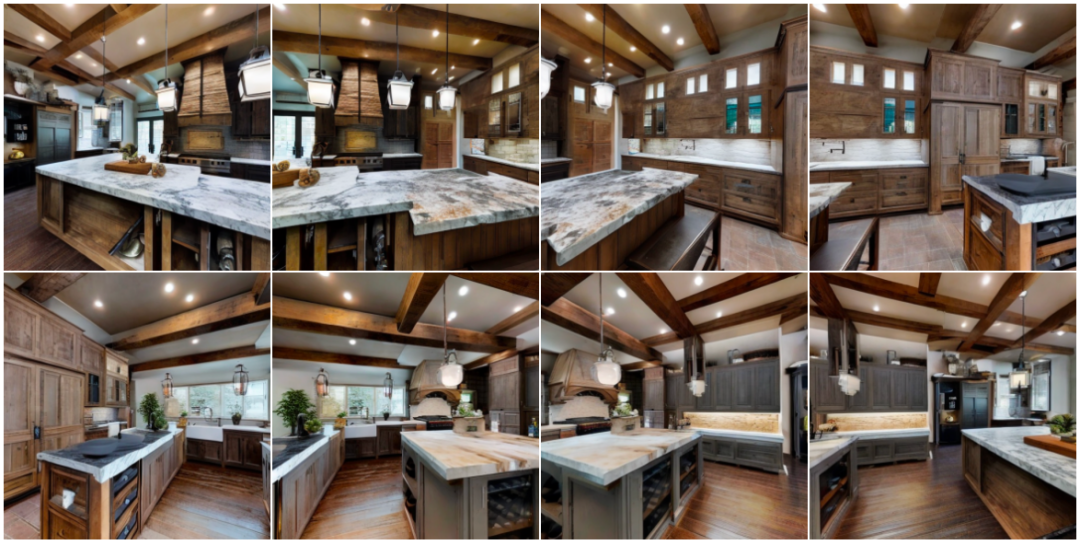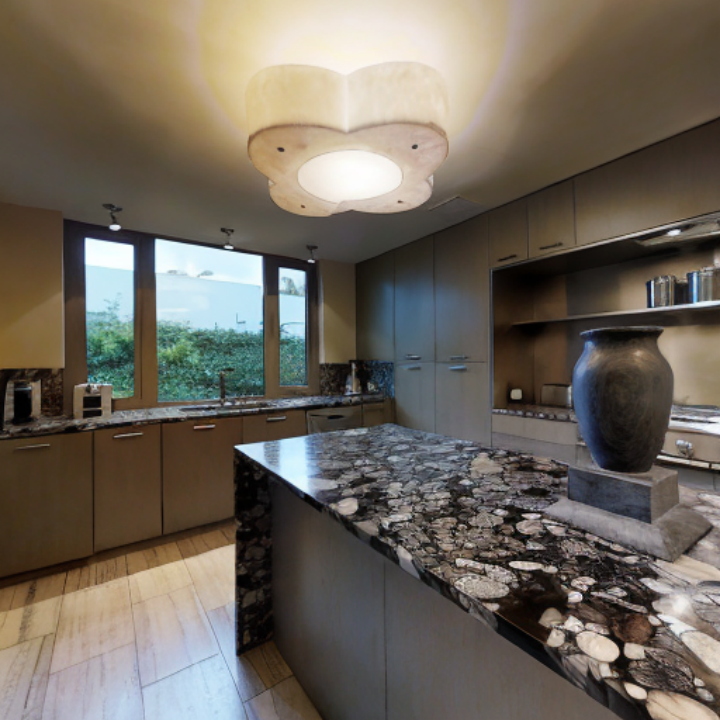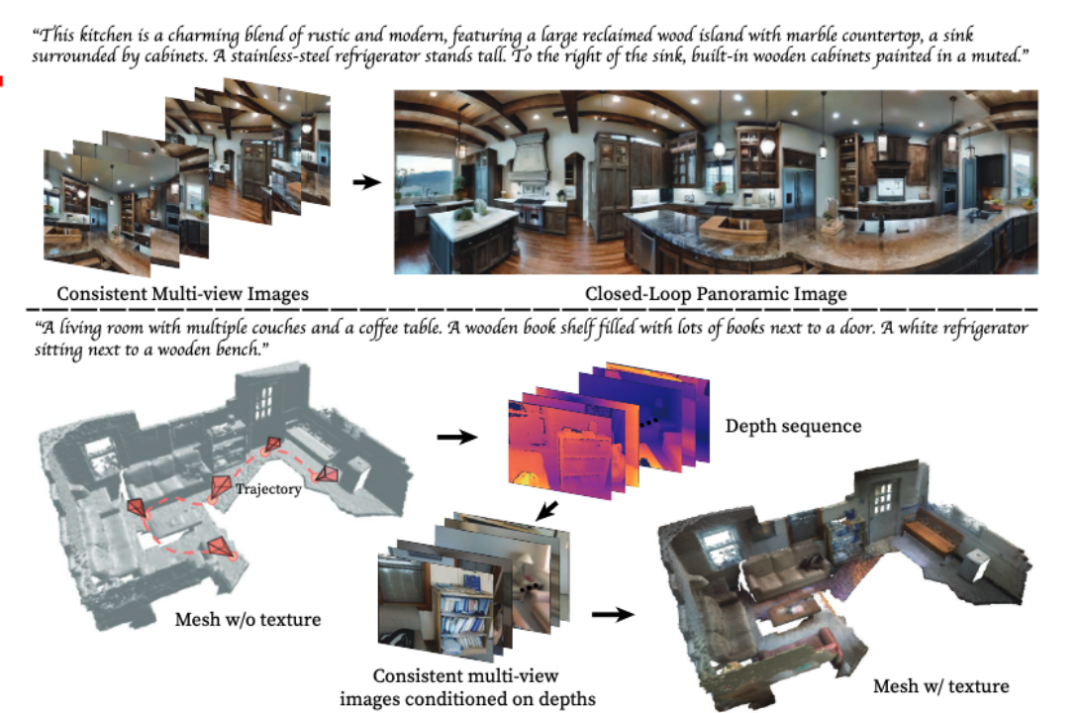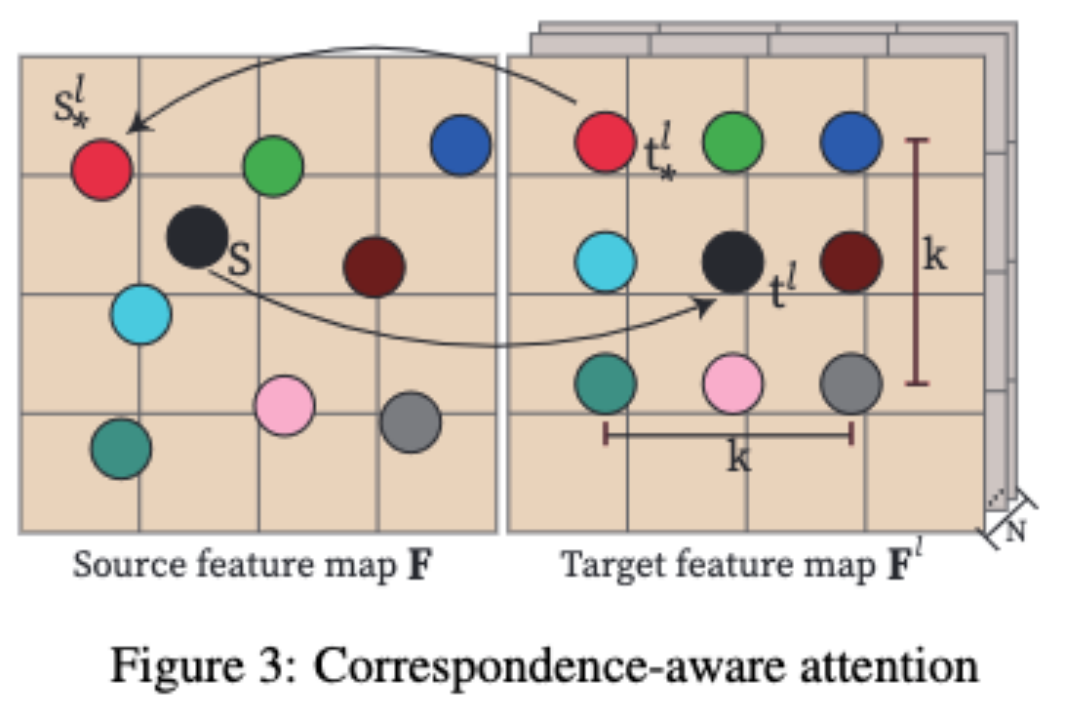 Technology peripherals
Technology peripherals
 AI
AI
 MVDiffusion: Achieve high-quality multi-view image generation and accurate reproduction of scene materials
MVDiffusion: Achieve high-quality multi-view image generation and accurate reproduction of scene materials
MVDiffusion: Achieve high-quality multi-view image generation and accurate reproduction of scene materials
Realistic image generation has wide applications in fields such as virtual reality, augmented reality, video games and film production.
With the rapid development of diffusion models in the past two years, major breakthroughs have been made in the field of image generation. A series of open source or commercial models derived from Stable Diffusion for generating images based on text descriptions have had a huge impact on design, games and other fields
However, how to generate images based on given Text or other conditions, producing high-quality multi-view images remains a challenge. Existing methods have obvious flaws in multi-view consistency
Currently common methods can be roughly divided into two categories
First The class method is dedicated to generating a scene picture and depth map, and obtaining the corresponding mesh, such as Text2Room, SceneScape - first use Stable Diffusion to generate the first picture, and then use Image Warping and Image Inpainting ) to generate subsequent pictures and depth maps using an autoregressive method.
However, such a solution can easily lead to errors gradually accumulating during the generation of multiple images, and there are usually closed-loop problems (such as when the camera rotates in a circle and returns to near the starting position) , the generated content is not completely consistent with the first picture), resulting in poor performance when the scene scale is large or the perspective changes between pictures.
The second type of method generates multiple pictures at the same time by extending the generation algorithm of the diffusion model to produce richer content than a single picture (such as generating a 360-degree panorama, or The content of an image is extrapolated infinitely to both sides), such as MultiDiffusion and DiffCollage. However, since the camera model is not considered, the results generated by this type of method are not true panoramas.
The goal of MVDiffusion is to generate multi-view images that conform to a given camera model. These images are Strictly consistent in content and globally semantically unified. The core idea of this method is to simultaneously denoise and learn the correspondence between images to maintain consistency

Please click the following link to view the paper: https ://arxiv.org/abs/2307.01097
Please visit the project website: https://mvdiffusion.github.io/
Demo : https://huggingface.co/spaces/tangshitao/MVDiffusion
Code: https://github.com/Tangshitao/MVDiffusion
Conference Published: NeurIPS (Key Points)
The goal of MVDiffusion is to generate multi-viewpoints with highly consistent content and unified global semantics through simultaneous denoising and global awareness based on the correspondence between images. Picture
Specifically, the researchers extended the existing text-picture diffusion model (such as Stable Diffusion), first allowing it to process multiple pictures in parallel, and further in the original An additional "Correspondence-aware Attention" mechanism is added to UNet to learn consistency between multiple perspectives and global unity.
By fine-tuning on a small amount of multi-view image training data, the resulting model can simultaneously generate multi-perspective images with highly consistent content.
MVDiffusion has achieved good results in three different application scenarios:
Generate multiple views based on text, and then splice them to Obtain a panorama
2. Extrapolate the perspective image (outpainting) to obtain a complete 360-degree panorama;
3. Generate for the scene Texture.
Application Scenario Display
Application 1: The process of panorama generation is to stitch together multiple photos or videos to create a panoramic perspective image or video. This process usually involves using special software or tools to automatically or manually align, blend and repair these images or videos. Through panorama generation, people can appreciate and experience scenes, such as landscapes, buildings, or indoor spaces, with a broader view. This technology has a wide range of applications in tourism, real estate, virtual reality and other fields (according to text)
Take generating a panorama as an example, enter a text describing the scene, MVDIffusion can generate multiple images of a scene Perspective Pictures
Enter the following to get 8 multi-perspective pictures: "This kitchen is a charming blend of country and modern, featuring a large reclaimed wood island with marble countertops, a A sink surrounded by cabinets. To the left of the island is a tall stainless steel refrigerator. To the right of the sink are built-in wooden cabinets painted in pastel colors."

These 8 pictures can be stitched into one panorama:

MVDiffusion also supports Provide a different text description for each image, but the descriptions need to be semantically consistent.
Application 2: The process of panorama generation is to stitch together multiple photos or videos to create a panoramic perspective image or video. This process usually involves using special software or tools to automatically or manually align, blend and repair these images or videos. Through panorama generation, people can appreciate and experience scenes, such as landscapes, buildings, or indoor spaces, with a broader view. This technology has wide applications in tourism, real estate, virtual reality and other fields (based on a perspective image)
MVDiffusion can extrapolate (outpainting) a perspective image into a complete 360-degree panorama picture.
For example, suppose we enter the following perspective:

MVDiffusion can further generate Panorama below:

It can be seen that the generated panorama semantically expands the input image, and the leftmost and rightmost The contents are connected (no closed-loop problems).
Application 3: Generating Scene Materials
Use MVDiffusion to generate materials (textures) for a given materialless scene mesh
Specifically, we first obtain multi-view depth maps by rendering mesh. Through the camera pose and depth map, we can obtain the correspondence between the pixels of multi-view images.
Next, MVDiffusion uses the multi-view depth map as a condition to simultaneously generate consistent multi-view RGB images.
Because the generated multi-view images can maintain a high degree of consistency in content, by projecting them back into the mesh, you can obtain a high-quality textured mesh.

The following are more effect examples:
The process of panorama generation is to combine multiple photos or videos Stitch images or videos together to create a panoramic view. This process usually involves using special software or tools to automatically or manually align, blend and repair these images or videos. Through panorama generation, people can appreciate and experience scenes, such as landscapes, buildings, or indoor spaces, with a broader view. This technology has wide applications in tourism, real estate, virtual reality and other fields




In this application scenario, It should be mentioned in particular that although the multi-view image data used in training MVDiffusion all come from panoramas of indoor scenes, and the styles are all single
, however, MVDiffusion does not Change the original stable diffusion parameters and just train the newly added Correspondence-aware Attention
Finally, the model can still generate multi-view pictures of various styles (such as outdoor, cartoon, etc.) based on the given text.
The content that needs to be rewritten is: single view extrapolation



Scene material generation

1. The process of panorama generation is to stitch together multiple photos or videos to create a panoramic perspective image or video. This process usually involves using special software or tools to automatically or manually align, blend and repair these images or videos. Through panorama generation, people can appreciate and experience scenes, such as landscapes, buildings, or indoor spaces, with a broader view. This technology has wide applications in tourism, real estate, virtual reality and other fields (according to text)
MVDiffusion simultaneously generates 8 overlapping images picture (perspective image), and then stitch these 8 pictures into a panorama. In these 8 perspective images, a 3x3 homographic matrix determines the pixel correspondence between each two images.
In the specific generation process, MVDiffusion first uses Gaussian random initialization to generate 8 views of pictures
Then, these 8 pictures The image is input into a Stable Diffusion pre-trained Unet network with multiple branches, and synchronous denoising is performed to obtain the generated result.
A new "Correspondence-aware Attention" module (light blue part in the picture above) has been added to the UNet network, which is used to learn the geometric consistency between cross-views, so that These 8 pictures can be stitched into a consistent panorama.
#2. The process of panorama generation is to stitch together multiple photos or videos to create a panoramic perspective image or video. This process usually involves using special software or tools to automatically or manually align, blend and repair these images or videos. Through panorama generation, people can appreciate and experience scenes, such as landscapes, buildings, or indoor spaces, with a broader view. This technology has a wide range of applications in tourism, real estate, virtual reality and more (according to a perspective picture)
MVDiffusion can also Complete a single perspective view into a panorama. The process of panorama generation is to stitch together multiple photos or videos to create a panoramic view of the image or video. This process usually involves using special software or tools to automatically or manually align, blend and repair these images or videos. Through panorama generation, people can appreciate and experience scenes, such as landscapes, buildings, or indoor spaces, with a broader view. This technology has a wide range of applications in tourism, real estate, virtual reality and other fields. MVDiffusion inputs randomly initialized 8 perspective pictures (including perspectives corresponding to perspective views) into the multi-branch Stable Diffusion Inpainting pre-trained UNet network.
In the Stable Diffusion Inpainting model, UNet uses an additional input mask to distinguish the conditional image from the image to be generated
The perspective corresponding to the perspective, the mask is set to 1, and the UNet of this branch will directly restore the perspective. For other perspectives, the mask is set to 0, and the UNet of the corresponding branch will generate a new perspective
Similarly, MVDiffusion uses the "Correspondence-aware Attention" module to learn to generate images and conditions Geometric consistency and semantic unity between images.
3. Scene material generation
MVDiffusion first generates RGB on a trajectory based on the depth map and camera pose. image, and then use TSDF fusion to mesh the generated RGB image with the given depth map.
The pixel correspondence of RGB images can be obtained through the depth map and camera pose.
The process of panorama generation is to stitch together multiple photos or videos to create a panoramic view of the image or video. This process usually involves using special software or tools to automatically or manually align, blend and repair these images or videos. Through panorama generation, people can appreciate and experience scenes, such as landscapes, buildings, or indoor spaces, with a broader view. This technology has a wide range of applications in tourism, real estate, virtual reality and other fields. We use multi-branch UNet and insert "Correspondence-aware Attention" to learn geometric consistency across perspectives.
4. Correspondence-aware Attention mechanism
##「Correspondence-aware Attention" (CAA), which is the core of MVDiffusion, is used to learn geometric consistency and semantic unity between multiple views.
MVDiffusion inserts the "Correspondence-aware Attention" block after each UNet block in the Stable Diffusion UNet. CAA works by considering a source feature map and N target feature maps.
For a location in the source feature map, we calculate the attention output based on the corresponding pixel and its neighborhood in the target feature map.

Specifically, for each target pixel t^l, MVDiffusion will pass the (x/y) coordinate Add integer displacement (dx/dy) to consider a K x K neighborhood, where |dx| represents the displacement in the x direction, |dy| represents the displacement in the y direction
In practical applications, the MVDiffusion algorithm uses K=3 and selects a 9-point neighborhood to improve the quality of the panorama. However, when generating multi-view images subject to geometric conditions, in order to improve operating efficiency, the calculation using the K=1

CAA module follows The standard attention mechanism, as shown in the formula above, where W_Q, W_K and W_V are the learnable weights of the query, key and value matrices; the target feature is not located at an integer position, but is obtained through bilinear interpolation.
The key difference is that position encoding is added to the target feature based on the 2D displacement (panorama) or 1D depth error (geometry) between the corresponding positions s^l and s in the source image .
In panorama generation (Application 1 and Application 2), this displacement provides the relative position in the local neighborhood.
And in depth-to-image generation (Application 3), disparity provides clues about depth discontinuities or occlusions, which is very important for high-fidelity image generation.
Please note that displacement is a concept containing a 2D (displacement) or 1D (depth error) vector. MVDiffusion applies standard frequency encoding to the x and y coordinates of the displacement
The above is the detailed content of MVDiffusion: Achieve high-quality multi-view image generation and accurate reproduction of scene materials. For more information, please follow other related articles on the PHP Chinese website!

Hot AI Tools

Undresser.AI Undress
AI-powered app for creating realistic nude photos

AI Clothes Remover
Online AI tool for removing clothes from photos.

Undress AI Tool
Undress images for free

Clothoff.io
AI clothes remover

Video Face Swap
Swap faces in any video effortlessly with our completely free AI face swap tool!

Hot Article

Hot Tools

Notepad++7.3.1
Easy-to-use and free code editor

SublimeText3 Chinese version
Chinese version, very easy to use

Zend Studio 13.0.1
Powerful PHP integrated development environment

Dreamweaver CS6
Visual web development tools

SublimeText3 Mac version
God-level code editing software (SublimeText3)

Hot Topics
 1669
1669
 14
14
 1428
1428
 52
52
 1329
1329
 25
25
 1273
1273
 29
29
 1256
1256
 24
24
 How to use the chrono library in C?
Apr 28, 2025 pm 10:18 PM
How to use the chrono library in C?
Apr 28, 2025 pm 10:18 PM
Using the chrono library in C can allow you to control time and time intervals more accurately. Let's explore the charm of this library. C's chrono library is part of the standard library, which provides a modern way to deal with time and time intervals. For programmers who have suffered from time.h and ctime, chrono is undoubtedly a boon. It not only improves the readability and maintainability of the code, but also provides higher accuracy and flexibility. Let's start with the basics. The chrono library mainly includes the following key components: std::chrono::system_clock: represents the system clock, used to obtain the current time. std::chron
 How to understand DMA operations in C?
Apr 28, 2025 pm 10:09 PM
How to understand DMA operations in C?
Apr 28, 2025 pm 10:09 PM
DMA in C refers to DirectMemoryAccess, a direct memory access technology, allowing hardware devices to directly transmit data to memory without CPU intervention. 1) DMA operation is highly dependent on hardware devices and drivers, and the implementation method varies from system to system. 2) Direct access to memory may bring security risks, and the correctness and security of the code must be ensured. 3) DMA can improve performance, but improper use may lead to degradation of system performance. Through practice and learning, we can master the skills of using DMA and maximize its effectiveness in scenarios such as high-speed data transmission and real-time signal processing.
 What is real-time operating system programming in C?
Apr 28, 2025 pm 10:15 PM
What is real-time operating system programming in C?
Apr 28, 2025 pm 10:15 PM
C performs well in real-time operating system (RTOS) programming, providing efficient execution efficiency and precise time management. 1) C Meet the needs of RTOS through direct operation of hardware resources and efficient memory management. 2) Using object-oriented features, C can design a flexible task scheduling system. 3) C supports efficient interrupt processing, but dynamic memory allocation and exception processing must be avoided to ensure real-time. 4) Template programming and inline functions help in performance optimization. 5) In practical applications, C can be used to implement an efficient logging system.
 Steps to add and delete fields to MySQL tables
Apr 29, 2025 pm 04:15 PM
Steps to add and delete fields to MySQL tables
Apr 29, 2025 pm 04:15 PM
In MySQL, add fields using ALTERTABLEtable_nameADDCOLUMNnew_columnVARCHAR(255)AFTERexisting_column, delete fields using ALTERTABLEtable_nameDROPCOLUMNcolumn_to_drop. When adding fields, you need to specify a location to optimize query performance and data structure; before deleting fields, you need to confirm that the operation is irreversible; modifying table structure using online DDL, backup data, test environment, and low-load time periods is performance optimization and best practice.
 How to measure thread performance in C?
Apr 28, 2025 pm 10:21 PM
How to measure thread performance in C?
Apr 28, 2025 pm 10:21 PM
Measuring thread performance in C can use the timing tools, performance analysis tools, and custom timers in the standard library. 1. Use the library to measure execution time. 2. Use gprof for performance analysis. The steps include adding the -pg option during compilation, running the program to generate a gmon.out file, and generating a performance report. 3. Use Valgrind's Callgrind module to perform more detailed analysis. The steps include running the program to generate the callgrind.out file and viewing the results using kcachegrind. 4. Custom timers can flexibly measure the execution time of a specific code segment. These methods help to fully understand thread performance and optimize code.
 Top 10 digital currency trading platforms: Top 10 safe and reliable digital currency exchanges
Apr 30, 2025 pm 04:30 PM
Top 10 digital currency trading platforms: Top 10 safe and reliable digital currency exchanges
Apr 30, 2025 pm 04:30 PM
The top 10 digital virtual currency trading platforms are: 1. Binance, 2. OKX, 3. Coinbase, 4. Kraken, 5. Huobi Global, 6. Bitfinex, 7. KuCoin, 8. Gemini, 9. Bitstamp, 10. Bittrex. These platforms all provide high security and a variety of trading options, suitable for different user needs.
 Quantitative Exchange Ranking 2025 Top 10 Recommendations for Digital Currency Quantitative Trading APPs
Apr 30, 2025 pm 07:24 PM
Quantitative Exchange Ranking 2025 Top 10 Recommendations for Digital Currency Quantitative Trading APPs
Apr 30, 2025 pm 07:24 PM
The built-in quantization tools on the exchange include: 1. Binance: Provides Binance Futures quantitative module, low handling fees, and supports AI-assisted transactions. 2. OKX (Ouyi): Supports multi-account management and intelligent order routing, and provides institutional-level risk control. The independent quantitative strategy platforms include: 3. 3Commas: drag-and-drop strategy generator, suitable for multi-platform hedging arbitrage. 4. Quadency: Professional-level algorithm strategy library, supporting customized risk thresholds. 5. Pionex: Built-in 16 preset strategy, low transaction fee. Vertical domain tools include: 6. Cryptohopper: cloud-based quantitative platform, supporting 150 technical indicators. 7. Bitsgap:
 How does deepseek official website achieve the effect of penetrating mouse scroll event?
Apr 30, 2025 pm 03:21 PM
How does deepseek official website achieve the effect of penetrating mouse scroll event?
Apr 30, 2025 pm 03:21 PM
How to achieve the effect of mouse scrolling event penetration? When we browse the web, we often encounter some special interaction designs. For example, on deepseek official website, �...



